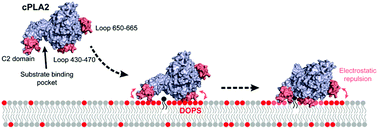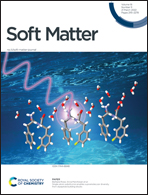Membrane phosphatidylserine allosterically regulates the cytosolic phospholipase A2 activity via an electrostatic-switch mechanism†
Abstract
Phospholipase A2 (PLA2) is a peripheral membrane protein that plays an essential role in many inflammatory responses. However, the activation mechanisms of PLA2 on the membrane surface have not been fully understood. Herein, we have combined experimental techniques and theoretical approaches to investigate the activation and association of the PLA2 protein on an artificial phospholipid membrane. Using a phosphatidylserine (PS) nanodomain containing membrane to mimic the inflammatory conditions, we found that the activity of cytosolic PLA2s (cPLA2s) increases with higher ratios of PS in the membrane. Molecular dynamics simulations reveal that significant changes in the protein structure are related to negatively charged membranes. In particular, the alteration of negatively charged residues in the C2 domain brings about an opened binding pocket and the catalytic site access to the substrate phospholipid. Meanwhile, the negative residues in the loop 650–665 facilitate the optimal interfacial orientation of the protein with a closed binding pocket on the membrane surface. These results lead us to suggest an electrostatic-switch allosteric mechanism for cPLA2 activation on the cell membrane surface under the inflammatory state.



 Please wait while we load your content...
Please wait while we load your content...